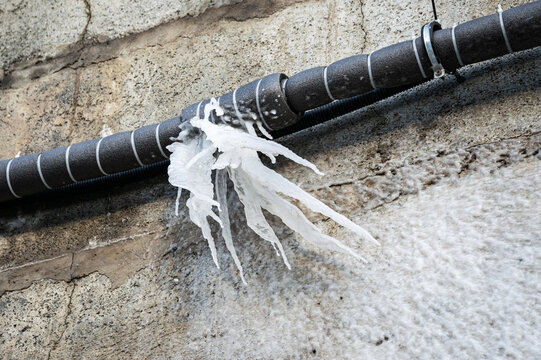Prevent Frozen Pipes in Winter: Expert Strategies
Prevent Frozen Pipes in Winter: Expert Strategies
Blog Article
On this page further down you will discover a bunch of high-quality ideas on the subject of How To Avoid Freezing Pipes.

Winter can damage your pipes, particularly by freezing pipes. Right here's how to prevent it from occurring and what to do if it does.
Introduction
As temperature levels drop, the danger of icy pipelines increases, potentially causing pricey repair work and water damage. Comprehending how to avoid frozen pipelines is important for property owners in cold environments.
Prevention Tips
Protecting at risk pipelines
Cover pipes in insulation sleeves or make use of warmth tape to safeguard them from freezing temperatures. Focus on pipelines in unheated or outside areas of the home.
Home heating methods
Keep indoor spaces appropriately heated up, particularly locations with plumbing. Open cabinet doors to permit cozy air to flow around pipes under sinks.
Just how to determine icy pipes
Seek lowered water circulation from taps, unusual smells or sounds from pipelines, and visible frost on subjected pipelines.
Long-Term Solutions
Structural changes
Think about rerouting pipelines far from outside walls or unheated locations. Include additional insulation to attic rooms, cellars, and crawl spaces.
Upgrading insulation
Invest in top quality insulation for pipelines, attic rooms, and walls. Proper insulation helps preserve regular temperatures and minimizes the danger of frozen pipes.
Protecting Exterior Plumbing
Yard hose pipes and outdoor taps
Detach and drain pipes garden pipes prior to wintertime. Set up frost-proof spigots or cover outdoor faucets with insulated caps.
Recognizing Frozen Pipes
What triggers pipelines to ice up?
Pipes ice up when revealed to temperatures listed below 32 ° F (0 ° C) for expanded durations. As water inside the pipes ices up, it expands, taxing the pipe walls and possibly triggering them to rupture.
Threats and problems
Icy pipes can result in water supply disruptions, building damage, and expensive repair services. Ruptured pipelines can flooding homes and trigger comprehensive architectural damages.
Indicators of Frozen Pipeline
Determining frozen pipelines early can stop them from bursting.
What to Do If Your Pipelines Freeze
Immediate actions to take
If you think frozen pipelines, maintain taps open up to ease pressure as the ice melts. Make use of a hairdryer or towels taken in warm water to thaw pipelines gradually.
Verdict
Avoiding frozen pipes requires aggressive measures and fast reactions. By comprehending the reasons, indicators, and safety nets, property owners can shield their plumbing throughout winter.
6 Proven Ways to Prevent Frozen Pipes and Protect Your Home
Disconnect and Drain Garden Hoses
Before winter arrives, start by disconnecting your garden hoses and draining any remaining water. Close the shut-off valves that supply outdoor hose bibs and leave the outdoor faucet open to allow any residual water to drain. For extra protection, consider using faucet covers throughout the colder months. It’s also important to drain water from any sprinkler supply lines following the manufacturer’s directions.
Insulate Exposed Pipes
Insulating your pipes is an effective way to prevent freezing. Pipe insulation is readily available at home improvement stores and is relatively inexpensive. Pay close attention to pipes in unheated areas such as the attic, basement, crawl spaces, or garage. Apply foam insulation generously to create a buffer against the cold. You can also wrap your pipes in heat tape or thermostat-controlled heat cables for added warmth.
Seal Air Leaks
Inspect your home for any cracks or openings that could let in cold air. Seal any holes around the piping in interior or exterior walls, as well as the sill plates where your home rests on its foundation. Additionally, make sure to keep your garage door closed unless you’re entering or exiting. Leaving it open creates a significant air leak that can lead to frozen pipes.
Allow Warm Air Circulation
During cold snaps, it’s essential to allow warm air to circulate evenly throughout your home. Leave interior doors ajar to promote better airflow. Open kitchen and bathroom cabinets to help distribute heat consistently around the rooms. If you have small children or pets, be sure to remove any household chemicals or potentially harmful cleaners from open cabinets for safety.
Let Faucets Drip
A small trickle of water can make a big difference in preventing ice formation inside your pipes. When temperatures drop significantly, start a drip of water from all faucets served by exposed pipes. This continuous flow helps prevent the water from freezing. Additionally, running a few faucets slightly can relieve pressure inside the pipes, reducing the chances of a rupture if the water inside does freeze.
https://choateshvac.com/6-proven-ways-to-prevent-frozen-pipes-and-protect-your-home/

Do you enjoy reading up on Winter Plumbing Precautions: Preventing Frozen Pipes? Write feedback down the page. We will be happy to know your thinking about this posting. In hopes that you come back again in the near future. Please take the time to distribute this article if you liked it. Thanks a lot for your time invested reading it.
Get A Quote Report this page